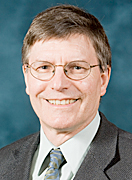Meeting Program — April 2018

Johannes W. Schwank
James and Judith Street Professor of Chemical Engineering
Department of Chemical Engineering
University of Michigan
Ann Arbor, Michigan
Abstract — Two novel automotive emission control catalyst architectures will be discussed, namely core@shell structures for low-temperature three-way catalysts, and cobalt-based nanorod structures for diesel oxidation catalysts that minimize expensive platinum-group metals.
Encapsulating an active metal core such as palladium in a porous oxide shell material can lead to improved catalytic activity, selectivity, and thermal stability compared to conventional supported catalysts. Maintaining high dispersion of palladium is critical for Pd-based automotive emission control catalysts, which suffer from deactivation due to sintering at high temperatures (≥ 800 °C). Here, we report direct evidence that Pd nanoparticles (~4 nm) can redisperse into small nanoclusters after aging at 800 °C, where severe Pd sintering would be expected on supported Pd catalysts. The Pd redispersion was confirmed by in situ, as well as ex situ, high-resolution transmission electron microscopy, and is manifested by the decreased CO light-off temperature. These novel core@shell structures exhibited remarkable thermal stability, maintaining the particle size and pore structure at very high temperatures (800–900 °C), close to those one may encounter in three-way automotive emission control applications.
Co3O4-In2O3 binary oxide nanorods offer a pathway for low-cost, efficient diesel emission control systems. The catalytic tests results showed that the catalysts were highly active for CO and propene oxidation, with low temperature light-off curves. The activity and stability of these cobalt oxide catalysts were comparable to platinum-based catalysts, indicating that they could be a potential substitute for platinum-based catalysts for diesel emission control.
Biography — Johannes Schwank holds a Ph. D. degree in Physical Chemistry from Innsbruck University in Austria. He joined the faculty at the University of Michigan in 1980 where he rose through the ranks and became Full Professor of Chemical Engineering in 1990. He served as Chairman of the Chemical Engineering Department from 1990 – 1995, as Interim Director of the University of Michigan Energy Institute 2011/2012, and as Director of EMAL (Electron Microbeam Analysis Laboratory), a campus-wide user facility 2013–2015. He is the holder of the James and Judith Street Chair in Chemical Engineering and the Director of REFRESCH, an interdisciplinary project that deals with food, energy, and water security in resource–constrained environments.
He serves on multiple editorial boards and industrial and academic advisory boards. He has co-founded a successful start-up company, Akervall Technologies. He is the author of more than 200 refereed publications, and holds 15 patents. His research group is working on a wide range of topics, including nanostructured materials for catalysis, energy storage, and gas sensing applications; synthetic fuels; biomass conversion; hydrogen production; solid oxide fuel cells; automotive emission control catalysts; photocatalysis; and novel catalyst synthesis and characterization methods.